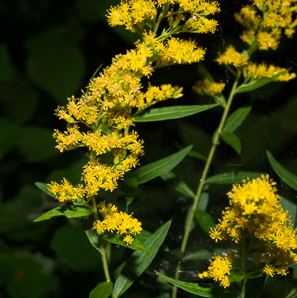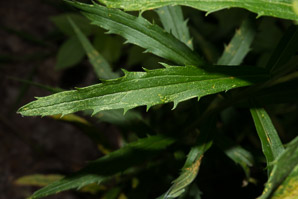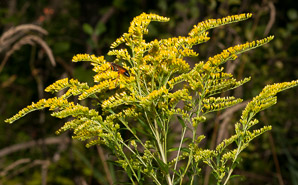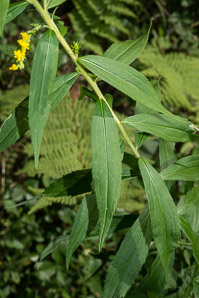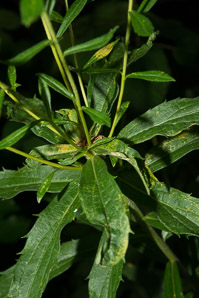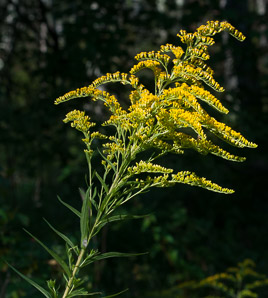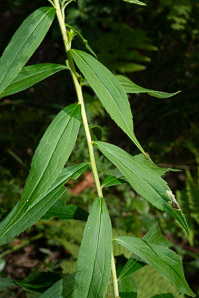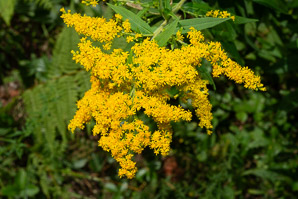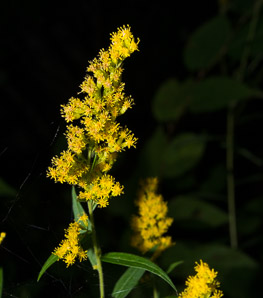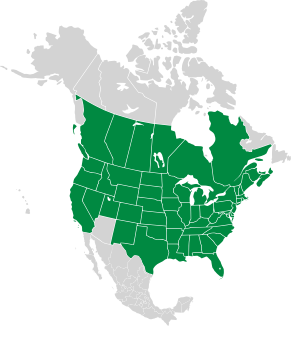Solidago gigantea Aiton
Smooth goldenrod, giant goldenrod
Kingdom Plantae Plants, but not fungi, lichens, or algae
Subkingdom Tracheobionta Vascular plants—plants with a “circulatory system” for delivering water and nutrients
Division Magnoliophyta Flowering plants, also known as angiosperms
Class Magnoliopsida Dicotyledons—plants with two initial seed leaves
Subclass Asteridae A large class that encompasses asters
Order Asterales Flowering plants with a central disk flower and surrounding petals, like daisies
Family Asteraceae The aster family, which also includes daisies and sunflowers; from the Greek ἀστήρ, “star,” for the star-shaped flowers
Genus Solidago From Latin solido, “to make whole or heal,” because it was believed these species had healing properties
Species gigantea Very large: from Giganteus, “of or belonging to the giants”
About plant names...
Giant goldenrod is a North American native. For a comparison chart of some of the varieties of goldenrods, see
Solidago .
Identification: Plants are 3-7′ (91-213 cm) tall, erect. They are
fond of boundaries of wetlands and shaded floodplains.
Stems are light green
or pale purple, hairless lanceolate roughly equal
in size alternate sessile three veins
Online References:
Illinois Wildflowers
Turner Photographics' Wildflowers site
The U.S. Geological Survey's Northern Prairie Wildlife Research Center
Plants for a Future, a resource and information centre for edible and otherwise useful plants
The Connecticut Botanical Society's Connecticut wildflowers site
EFloras
References:
Clemants, Steven; Gracie, Carol, Wildflowers in the Field and Forest , Oxford University Press, 2006 , p. 156
8/23/2013 · Andres Institute of Art, Big Bear Mountain, Brookline, New Hampshire · ≈ 8 × 5″ (19 × 12 cm)
8/23/2013 · Andres Institute of Art, Big Bear Mountain, Brookline, New Hampshire · ≈ 7 × 4½″ (18 × 12 cm)
8/11/2010 · Nashua River Rail Trail, Groton Center, Groton, Massachusetts · ≈ 12 × 8″ (31 × 20 cm)
8/24/2013 · Cranberry Meadow Pond Trail, Monadnock Conservancy, Peterborough, New Hampshire · ≈ 8 × 6″ (20 × 14 cm)
Older scientific or horticultural names
Aster latissimifolius (Mill.) Kuntze var. serotinus Kuntze
Solidago gigantea Aiton var. leiophylla Fernald
Solidago gigantea Aiton var. pitcheri (Nutt.) Shinners
Solidago gigantea Aiton var. serotina (Kuntze) Cronquist
Solidago gigantea Aiton ssp. serotina (Kuntze) McNeill
Solidago gigantea Aiton var. shinnersii Beaudry
Solidago ×leiophallax Friesner
Solidago pitcheri Nutt.
Solidago serotina Aiton, non Retz.
Solidago serotinoides Á. Löve & D. Löve
Solidago gigantea description by Thomas H. Kent, last updated 25 May 2020.
© FloraFinder.org. All rights reserved.
8/23/2013 · Andres Institute of Art, Big Bear Mountain, Brookline, New Hampshire · ≈ 4½ × 7″ (12 × 18 cm)
8/11/2010 · Nashua River Rail Trail, Groton Center, Groton, Massachusetts · ≈ 1½ × 1′ (52 × 34 cm)
8/24/2013 · Cranberry Meadow Pond Trail, Monadnock Conservancy, Peterborough, New Hampshire · ≈ 6 × 8″ (14 × 20 cm)
8/24/2013 · Cranberry Meadow Pond Trail, Monadnock Conservancy, Peterborough, New Hampshire · ≈ 8 × 6″ (20 × 14 cm)
8/23/2013 · Andres Institute of Art, Big Bear Mountain, Brookline, New Hampshire · ≈ 4½ × 7″ (12 × 18 cm)
Range:
About this map...

